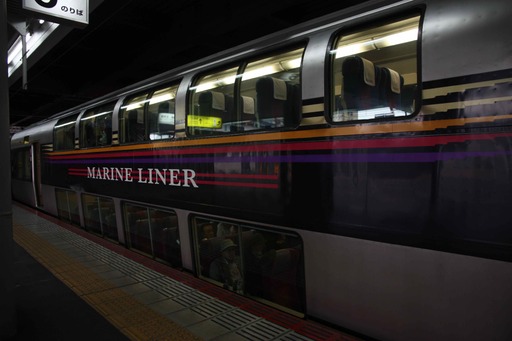
Having breakfasted and handed over the Monster it was time to light out for the station, where we were booked into the prime seats on the prime train that crosses over to Shikoku, but that was strictly a one way arrangement. Japanese trains, in an economy where space is at a premium and efficiency is prized (at least in some areas) can usually be driven from either end, and when they arrive at the terminus it's simply a case of the driver changing ends, and they're set to go on the return journey.
The same thing operates on services in Australia like the Gold Coast line, but we still, from what I can gather, do the old switcheroo bit with something like the Sunlander, taking the locomotive down to the other end of the train for the return journey.
The astute observer will note the Shinkansen invariably have a power unit at either end, and, more often than not, one more somewhere in the middle, which explains why Car 1 is always at that end of the train, regardless of the actual direction of travel. If you're in the right place at the turn around point you'll see something more interesting.
We all like to travel looking forward in the direction we're going, don't we?
So what happens when it's turnaround time for the Shinkansen? Well, you have the seats turned to face the new direction, don't you?
These factors hadn't registered until I sat down to ponder the return journey across the bridge. We'd been told there was no point in holding the same seats for the return journey because they'd be looking backwards.

Until the train itself pulled in, I'd thought we'd be in some sort of sightseeing bubble, up above the body of the train, which meant, when you look at it that way, that the foregoing bit makes a certain amount of sense. We got to the platform just as the train arrived, disgorging the usual morning crowd of salarymen, office workers another individuals, and once the flood had passed, set off to find ours eats, which were tucked way just behind the driver's compartment at the very front of the train.
There are four seats, predictably tagged 1 A, B, C and D. Presumably there's a similar compartment at the other end of the train where the seat labels start with a 2. They are, by the way, seemingly the only reserved seats on the whole train.
And a word to the wise, if you're looking to do the bridge trip. Japanese engine drivers sit in consoles on the left hand side, so if you're in 1 A or B on the outward leg your panoramic view to the front will feature the back of the driver's head. Presumably the same thing applies to C and D on the way back.